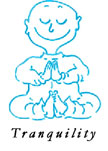
The Ten Worlds is a way to
describe how life seems to change from moment to moment. Although some
of these "worlds" might seem better than others, they are all necessaary
parts of life. And we always have the ability to make these worlds more
enlightened. The worlds all have positive side as well as negative sides.
The purpose of Buddhism is
to make the world of Buddhahood our most frequent state.

HELL
A condition in which
one feels totally trapped and filled with frustration, rage, helplessness,
and destructive impulses. In this state, the person is suffering.
Being poor or sick or in jail
might show what this state is like. The positive thing about Hell is the
feeling of "hitting the bottom" — this can help the person to change and
improve things.
One example might be a person
who has been ill and then uses suffering to become more healthy. This is
called "turning poison into medicine."
|
 |
HUNGER
A person in this state
is always craving things. But the feeling doesn't go away, even when he
or she gets the thing! So the person just keeps wanting more.
When hunger is seen positively,
it can create an unstoppable drive. For example, people fighting tirelessly
for nuclear disarmament are hungry for peace.
|
 |
ANIMALITY
This is a condition
that is ruled by animal instinct. A person has no sense of reason, living
only for the present. One in this state fears the strong and prays on the
weak. Because of this he or she may be seen as "two-faced."
On the positive side, animality
protects one from danger and alerts us to basic needs such as food and
shelter.
|
 |
ANGER
This is a condition
dominated by selfish ego, competitiveness, arrogance and the need to be
right about all things. Anger can also be the source of great ideas and
fuel for achievement.
Many organizations which work
for social change have been driven by people with a burning sense of anger
and indignation at the way people are being treated. This is the positive
side of Anger.
|
 |
TRANQUILITY
In this calm state
of life one can pass fair judgment, and can control desires with
reason. A person can act in harmony with the environment.
However, like most of these
ten worlds it is unstable and hard to maintain. So while this might be
a good state to be in, it is unable to endure the conflicts which we face
in our daily lives.
|
 |
RAPTURE
This is the condition
of pleasure, that is often experienced when a person's desires are fulfilled.
Unlike the true happiness of Buddhahood, however, this state is only temporary.
Like Tranquility, it is easily disrupted by even a slight challenge. And
even if things do not change, Rapture simply disappears with the passage
of time.
|
 |

The majority of people spend
most of their time moving between these six conditions of life, from Hell
to Rapture, totally ruled by their reactions to outside events. They may
be easily swayed by things that happen in their lives.
The next four worlds are called
the four higher worlds or the Four Noble Paths. A person must make an effort
to reveal these worlds within his or her life.

LEARNING
A condition in which
one seeks some skill, lasting truth, or self reformation from the teachings
of others. When you shonestly study in school, you are in the world of
Learning.
A person in a state of learning
nevertheless, may not be in a position to make decisions or take action.
|
 |
REALIZATION (or Absorption)
This is a state where
a person discovers a partial truth through his or her own efforts. The
worlds of Learning and Realization are closely related.
The problem with Learning
and Realization is that people in these states may become arrogant and
self-centered. They may look down on those people who seem "less smart"
than themselves. They may start to think that they have nothing to learn.
Also, people in these states
find it hard to admit mistakes.
|
 |
BODHISATTVA
This is a condition
where a person does not just think only of himself (or herself). This person
is devoted to helping others.
Some examples might be nurses
or emergency rescue workers or teachers.
But even this state can have
a negative side: the Bodhisattva may continue to act for others, but, over
time, may come to resent doing it.
|
 |
BUDDHAHOOD
The highest of the
Ten Worlds, a condition of pure, indestructible happiness which is not
dependent on what is happening in one's life. The Buddha is happy, no matter
what: problems in life are seen as challenges to be overcome. It is a condition
of freedom, full of wisdom, courage, compassion, and life force.
|
 |

We have the ability to reveal
any of our Ten Worlds, including Buddhahood, from the first moment we chant.
As we continue to practice Buddhism, Buddhahood becomes our most frequent
world. And we begin to show the positive sides of all the other worlds
too.
In this way, based on our daily
chanting, our lives become charged with positive, value-creating activity.
We are able to change our environment — our family, our friends, home,
school and/or workplace — and become happy.
We can help others to become
happy too, by teaching them to chant.

NOTE: You can get a full-size version of this
Ten Worlds presentation (with large pictures suitable for coloring) as
a Word document — click
here.
|









